How to box a bike
We recommend always taking a bicycle along on vacations. That way, when your significant other is swapping stories with long-lost high-school chums, you can be riding! Plus, you won’t worry about all those calorie-rich meals if your exercise machine is ready and waiting.
For driving trips, it’s easy to carry the bike on a vehicle rack. When you fly, however, you must box your bike to meet airline requirements and because it’s the best way to safeguard it. Once boxed, you can check the bicycle as luggage and take it with you so it arrives when you do. The airlines usually charge a fee for bicycles, so be prepared by checking with your carrier beforehand. To avoid this fee and the hassle of checking in with your bike, an alternative is shipping it via United Parcel Service (UPS). That way, the bike will be waiting for you when you arrive. Whether you fly with your bike or ship it to your vacation destination, you’ll need to partially disassemble it and box it. This takes about an hour.
To help, we’ve prepared these instructions. Please call or visit us if you have any questions.
Materials NeededObviously, you’ll need a bike box. These are available from us (a nominal fee might apply). Call first to check availability. We need to know your bike size to select the right box, too. Another specialty item is a fork protection block. This is inserted into the fork to prevent damage. We can supply this or you can make one out of a 1- x 1-inch block of wood 100mm long with screws and washers in the ends. We can also provide an axle protector, which is pressed onto the front axle to keep it from poking through the box. Or you can cover the axle with cardboard. Required Tools
| |
 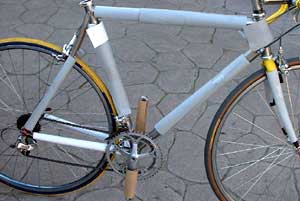 Remove the pedals, seat and seatpost. To prevent injury, use pliers to carefully remove any loose large staples in the box top (often used to seal boxes at the factory). Put your shopping bag on your bench to receive the small parts. Shift the bicycle chain onto the small chainring and largest rear cog. Now remove the pedals by turning the right counterclockwise and the left clockwise (the left pedal is “reverse threaded”). Put the pedals in the parts bag. Loosen and remove the seatpost and seat as a unit and place it on the bench (snug the seatpost bolt in the frame so it won’t fall out). If you have bolt-on aero handlebars, remove them and put them on the bench for now. Remove any bar ends and put them in your parts bag. Ditto for water-bottle cages. If you have a computer, remove it, wrap it and put it in the parts bag. Then remove the computer mount from the handlebar, unwrap its wire from the brake cable and tie it out of the way so it doesn’t get damaged. Wrap the frame, fork and crankarms (photo), (tape the wraps in place.) Remove the pedals, seat and seatpost. To prevent injury, use pliers to carefully remove any loose large staples in the box top (often used to seal boxes at the factory). Put your shopping bag on your bench to receive the small parts. Shift the bicycle chain onto the small chainring and largest rear cog. Now remove the pedals by turning the right counterclockwise and the left clockwise (the left pedal is “reverse threaded”). Put the pedals in the parts bag. Loosen and remove the seatpost and seat as a unit and place it on the bench (snug the seatpost bolt in the frame so it won’t fall out). If you have bolt-on aero handlebars, remove them and put them on the bench for now. Remove any bar ends and put them in your parts bag. Ditto for water-bottle cages. If you have a computer, remove it, wrap it and put it in the parts bag. Then remove the computer mount from the handlebar, unwrap its wire from the brake cable and tie it out of the way so it doesn’t get damaged. Wrap the frame, fork and crankarms (photo), (tape the wraps in place.) | |
 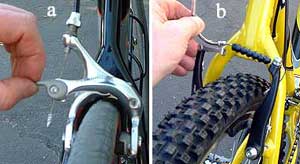 Create cable slack. Usually, you have to create cable slack and remove the front brake, or part of it, to be able to remove and move the handlebars. But, you don’t want to undo the cables at the anchor bolts because this means having to readjust everything upon your arrival. If you’re packing a road bike, open the brake quick releases to create slack (photo a). For off-road bikes, unhook the noodles from linear-pull brakes (photo b) or release the cable ends on cantilevers. To create slack in the shift cables, move the right lever as if you were shifting into a smaller cog and then pull outward on the front derailleur. On many bikes, this will let you release the shift-cable housing from the frame stops, which will provide plenty of slack. Create cable slack. Usually, you have to create cable slack and remove the front brake, or part of it, to be able to remove and move the handlebars. But, you don’t want to undo the cables at the anchor bolts because this means having to readjust everything upon your arrival. If you’re packing a road bike, open the brake quick releases to create slack (photo a). For off-road bikes, unhook the noodles from linear-pull brakes (photo b) or release the cable ends on cantilevers. To create slack in the shift cables, move the right lever as if you were shifting into a smaller cog and then pull outward on the front derailleur. On many bikes, this will let you release the shift-cable housing from the frame stops, which will provide plenty of slack. | |
 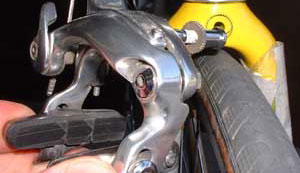 Remove the front brake. If you have a road bike with sidepull brakes, remove the front brake from the fork, reattaching its nut and any hardware (photo) and wrapping it in paper (do not detach the cable). For linear-pull and cantilever brakes, remove the side of the brake that’s attached to the cable and be sure to tape the parts together so they can’t get lost. Removing the brake like this retains your adjustment and lets the brake move with the handlebars. Remove the front brake. If you have a road bike with sidepull brakes, remove the front brake from the fork, reattaching its nut and any hardware (photo) and wrapping it in paper (do not detach the cable). For linear-pull and cantilever brakes, remove the side of the brake that’s attached to the cable and be sure to tape the parts together so they can’t get lost. Removing the brake like this retains your adjustment and lets the brake move with the handlebars. | |
 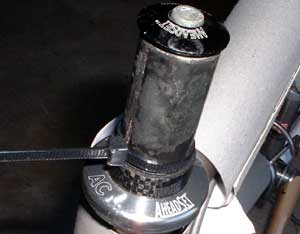 Remove the handlebars. If you have a stem that can be opened to remove the handlebars, do so and replace the stem bolts, snugging them so they won’t fall out and get lost during shipping (leave the stem in place on the bike). For other types of handlebars and stems, you’ll need to remove the bars and stem as a unit. For threadless models (bolts will be on the side/back of the stem), loosen and remove the top cap, then loosen the stem bolts and remove the stem. Be sure to reattach the top cap and spacers, noting their position for correct reassembly. Also, install a zip tie (or tape) around the top of the fork just above the top spacer (photo) so it won’t rattle or fall out of the frame. If you have a quill-type stem (bolt on top, inserts into steerer tube), loosen the bolt on top a few turns and tap it with a mallet, which will drive down the wedge inside loosening the stem in the frame. For now, temporarily rest or tie the handlebars/stem assembly to the left side of the bike (non-chain side). Remove the handlebars. If you have a stem that can be opened to remove the handlebars, do so and replace the stem bolts, snugging them so they won’t fall out and get lost during shipping (leave the stem in place on the bike). For other types of handlebars and stems, you’ll need to remove the bars and stem as a unit. For threadless models (bolts will be on the side/back of the stem), loosen and remove the top cap, then loosen the stem bolts and remove the stem. Be sure to reattach the top cap and spacers, noting their position for correct reassembly. Also, install a zip tie (or tape) around the top of the fork just above the top spacer (photo) so it won’t rattle or fall out of the frame. If you have a quill-type stem (bolt on top, inserts into steerer tube), loosen the bolt on top a few turns and tap it with a mallet, which will drive down the wedge inside loosening the stem in the frame. For now, temporarily rest or tie the handlebars/stem assembly to the left side of the bike (non-chain side). | |
 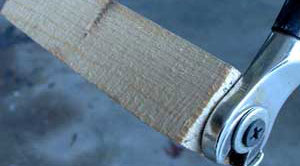 Remove the front wheel. Unscrew the quick release, extract it from the hub and then reassemble it and place it in the parts bag. Press the axle protector into one side of the axle. Put the fork protection block in place between the dropouts (photo). This simple device is important because it prevents serious damage to the fork should your box get dropped in shipping. Make sure it's attached securely so that it can't fall out during shipping. Remove the front wheel. Unscrew the quick release, extract it from the hub and then reassemble it and place it in the parts bag. Press the axle protector into one side of the axle. Put the fork protection block in place between the dropouts (photo). This simple device is important because it prevents serious damage to the fork should your box get dropped in shipping. Make sure it's attached securely so that it can't fall out during shipping. | |
 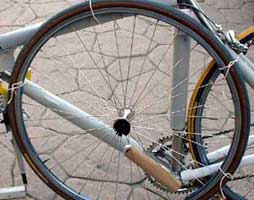 Tie the bike/wheel together. With the bike resting on the ground, place the wheel next to the left side of the bike with the axle protector facing out. Usually, you’ll have to weave the left crankarm between the spokes, which is why you wrapped it. Make sure no part of the crankarm touches any part of the rim and that the axle cannot touch the frame tubes. Then tie the wheel to the bike in several places so it can’t change position (photo). Tie the bike/wheel together. With the bike resting on the ground, place the wheel next to the left side of the bike with the axle protector facing out. Usually, you’ll have to weave the left crankarm between the spokes, which is why you wrapped it. Make sure no part of the crankarm touches any part of the rim and that the axle cannot touch the frame tubes. Then tie the wheel to the bike in several places so it can’t change position (photo). | |
 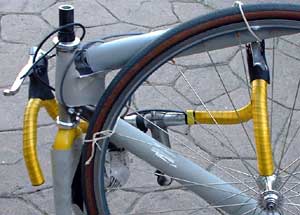 Position the handlebars. If you’re packing a bike with flat bars, you can usually fit the bars on top of the top tube and wheel. Place them so they’re as narrow as possible so the bike will pass through the box opening. And make sure that no part of the bars or stem can bang into the frame or rim. Add padding if needed. Then tie the bars in place. For dropped handlebars, try putting them under the top tube and partly inside the wheel (photo) or try resting the hooks on the top tube with the levers facing up. You may need to fine-tune the placement when the bike is in the box if the levers protrude too far. Levers are fragile and expensive, so situate them safely, padding them if necessary. Also, pay attention to the cables and housing so you don’t kink them. Maintain loops in the housing and keep trying until you find a handlebar position that’s safe. Position the handlebars. If you’re packing a bike with flat bars, you can usually fit the bars on top of the top tube and wheel. Place them so they’re as narrow as possible so the bike will pass through the box opening. And make sure that no part of the bars or stem can bang into the frame or rim. Add padding if needed. Then tie the bars in place. For dropped handlebars, try putting them under the top tube and partly inside the wheel (photo) or try resting the hooks on the top tube with the levers facing up. You may need to fine-tune the placement when the bike is in the box if the levers protrude too far. Levers are fragile and expensive, so situate them safely, padding them if necessary. Also, pay attention to the cables and housing so you don’t kink them. Maintain loops in the housing and keep trying until you find a handlebar position that’s safe. | |
 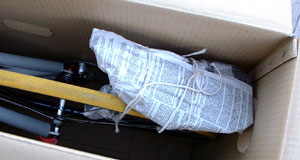 Box it! Tape your parts bag shut and place it in the bottom of the box (it’s a good idea to attach the bag to the bike so it can’t move around). Rotate the fork 180 degrees, which will make the package a little shorter. Now, lift the bike and place it into the box so that the parts bag ends up just behind the fork. Wrap the seat/seatpost, rest it on the rear wheel and tie it to the wheel so it’s can’t get loose and bang up your bike (photo). Pack aero handlebars similarly or wherever they fit best. If you removed it, tie or tape the front brake so it can’t bang into anything. As a precaution, put your name and address on a piece of paper and attach it to the bike. Then close and securely tape the box shut (don’t forget the bottom). Cross out any old addresses on the box (look carefully) because these could confuse the shipper. And, then write your shipping address on top of the box. You’re ready to go! Have a great biking holiday! Box it! Tape your parts bag shut and place it in the bottom of the box (it’s a good idea to attach the bag to the bike so it can’t move around). Rotate the fork 180 degrees, which will make the package a little shorter. Now, lift the bike and place it into the box so that the parts bag ends up just behind the fork. Wrap the seat/seatpost, rest it on the rear wheel and tie it to the wheel so it’s can’t get loose and bang up your bike (photo). Pack aero handlebars similarly or wherever they fit best. If you removed it, tie or tape the front brake so it can’t bang into anything. As a precaution, put your name and address on a piece of paper and attach it to the bike. Then close and securely tape the box shut (don’t forget the bottom). Cross out any old addresses on the box (look carefully) because these could confuse the shipper. And, then write your shipping address on top of the box. You’re ready to go! Have a great biking holiday! | |
Tips for boxing a bike |
| Before removing the seatpost, wrap a piece of tape around it right at the frame to mark your seat height so you’ll set things right during reassembly. If you have a quill-type stem (not threadless), mark its height, too. |
| Don’t just label the box. Write the complete address on a piece of paper attached to your bike, too. That way, if they ruin your box, they’ll still know where to deliver the bike and who it belongs to. |
| Be sure to cross out any old addresses or your bike might end up in the wrong place. |
| To make the box extra tough, reinforce it by putting cardboard panels inside next to the bike. |
| Tape the box carefully to reinforce all the seams (don't forget the bottom). |
| Don’t tape over the carrying holes because you want the shippers to have good handholds so they don’t get aggravated and abuse your bike. |
| Keep in mind that there’s room in the box for other essentials, such as cycling clothing and gear. Plus, on the return trip, the box is a great place to pack dirty clothes. |
| Don’t forget to pack the tools and materials needed to repack the bike for the return trip. |
